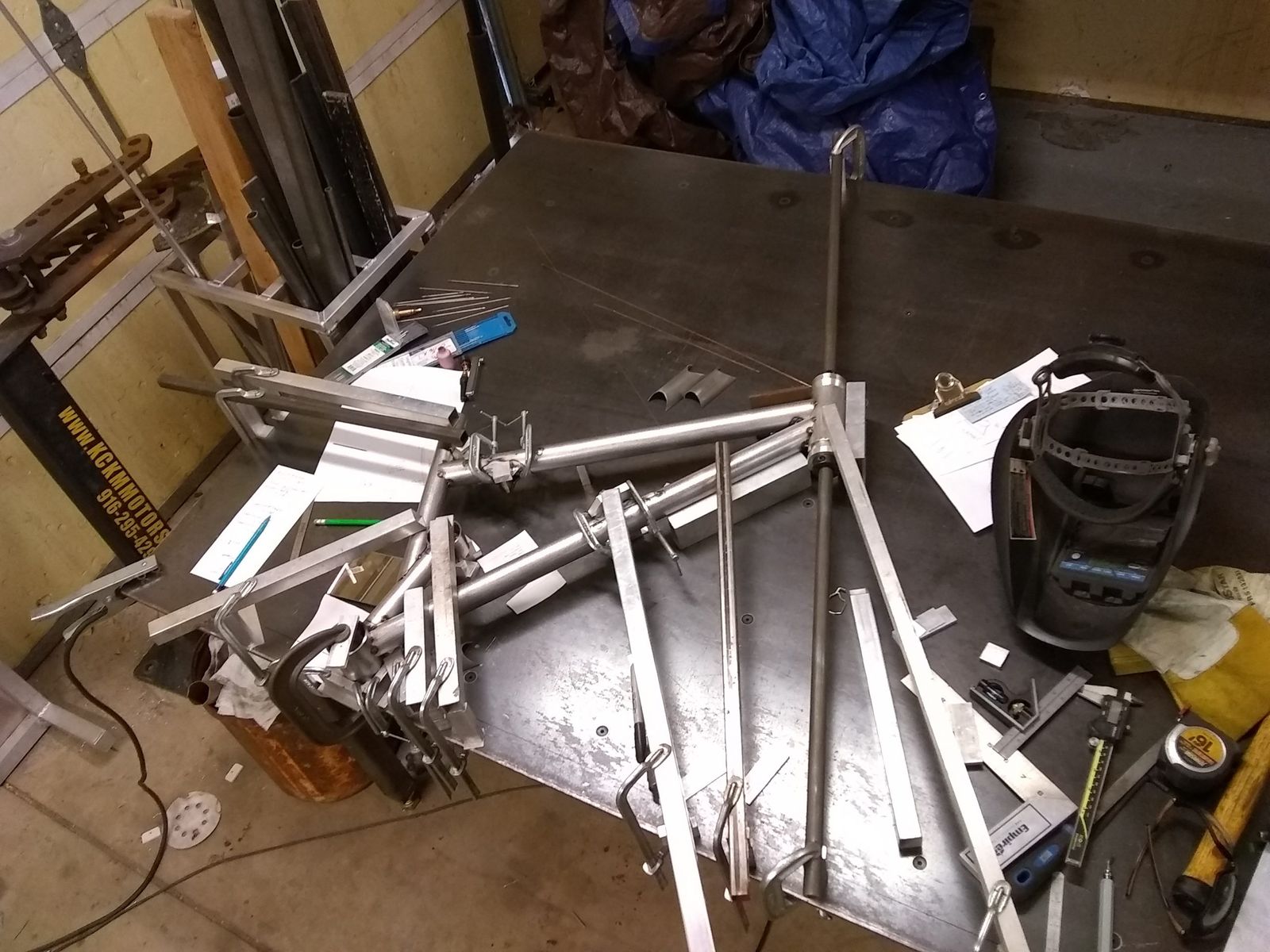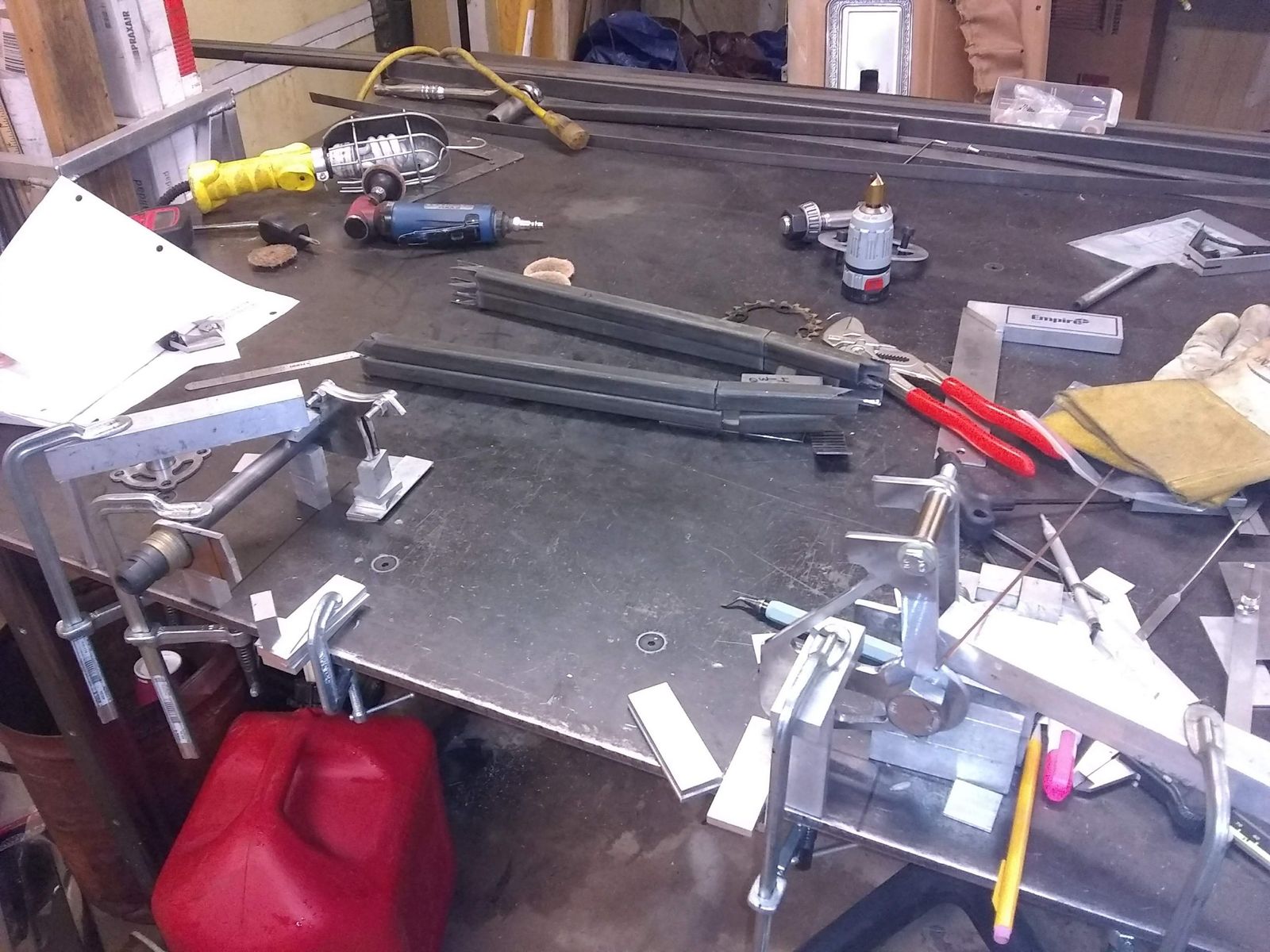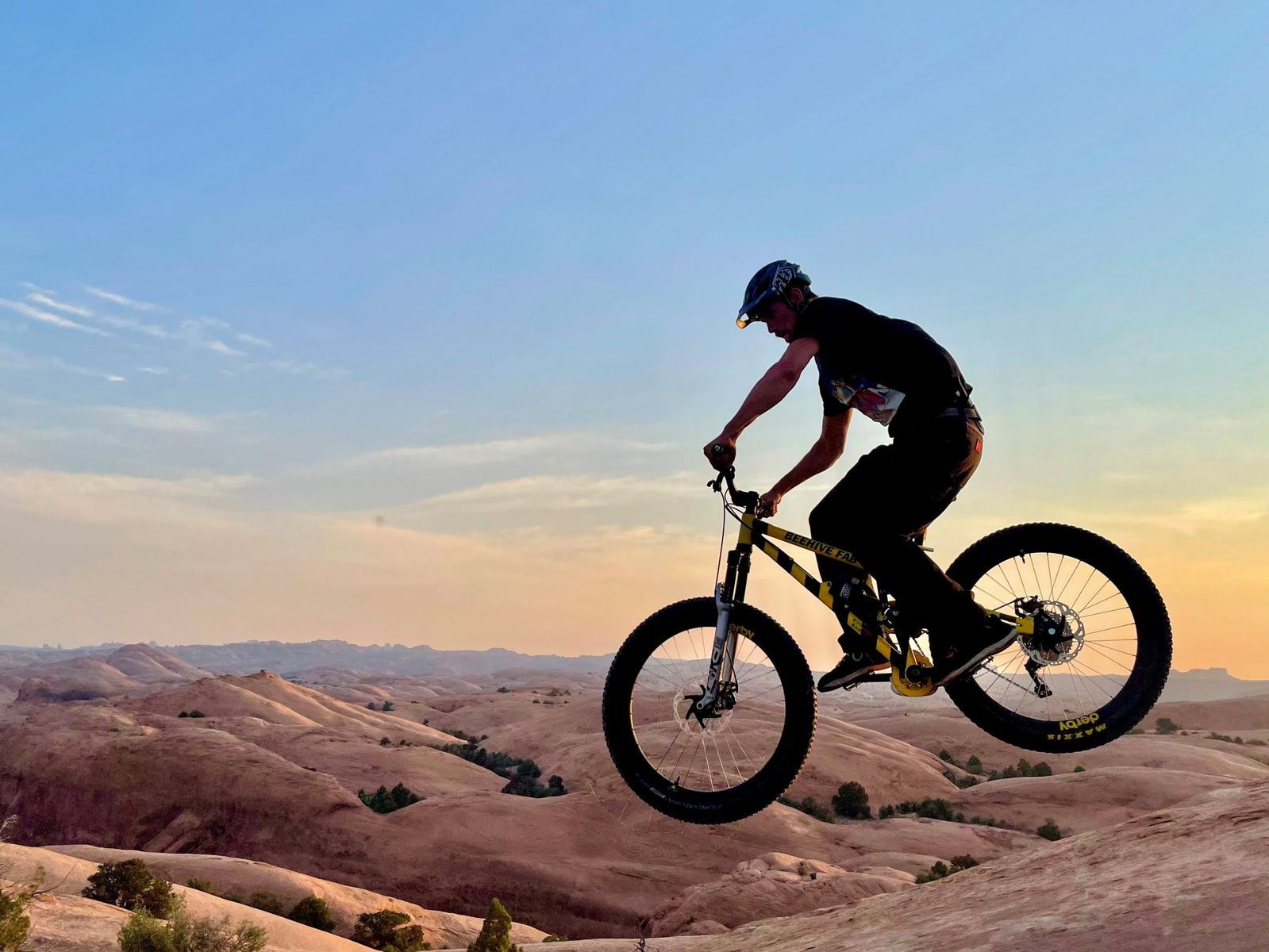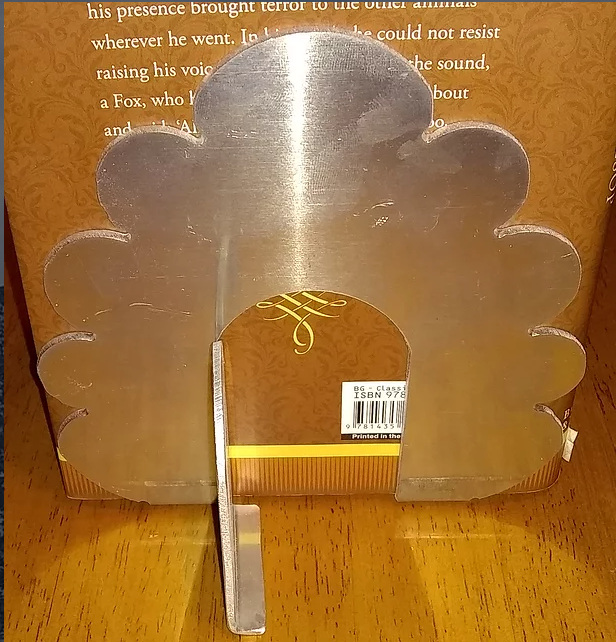In a moment of internet idleness important journalistic research, we spotted this BeeLine Bike by Beehive Fabrications in Moab, Utah. Unable to enter the country right now or jump on a plane for a first hand look, we had to settle for an email chat with its creator, Sage Cummisk. Ah well – it saved on the air miles, and you get a detailed look in Sage’s own words.

Who are you, where are you, and what’s your background with bike design and construction?
I am Sage. I have no formal education regarding bicycles, manufacturing, or engineering, it’s all been on the job or reading, experimenting, etc. of my own accord. I have been a mechanic at five bike shops since I first moved to Moab, Utah in 2007, where I currently reside. I gained general metalworking, machining, and welding experience at the three fabrication shops I’ve worked at since 2010 that exposed me further to the aerospace, off-road, oil/water drilling industries, every one having substantially different equipment and requiring different skill sets and materials knowledge but there is always some crossover too. Bicycles are equally distinct in both regards.
We all know bees are cool and essential to our very existence, but what’s the story behind the Beehive brand?
Latest Singletrack Merch
Buying and wearing our sustainable merch is another great way to support Singletrack
The name comes from a common ideal I shared with the settlers of Deseret and later Utah, where it is still the state emblem, in that they fancied themselves industrious (industry is the state motto) as honey bees (the state insect, which isn’t native to North America, it was introduced from Europe in the 17th century). Although, I think of industry in more modern terms of using machines to be as productive as possible, perhaps someday Beehive Fabrication Services, LLC will grow to a size where it better represents the medieval roots of the association where the bees working in mass create a product or accomplish a goal that could not have been done by one individually.

I notice you build a slopestyle bike first – is it still alive and well? What did you learn from that experience that you’ve brought to the BeeLine?
With the exception that it needs a new 6.5”x1.5” rear shock, which are unfortunately difficult to come by these days, it’s good to go, even got a fresh paint job last fall. It did take a hiatus from functioning for several years after it was stolen a while back, but luckily a few months afterward its possessor took it to Rim Cyclery where they walked it right past its own stolen bike flyer and then it was easily recognized by a friend of mine working there. Unfortunately, it was shy a fork and few other small parts when I got it back, but I only really cared about the frame. I learned from building it that: I don’t particularly like high bottom brackets, the line between acceptable and too falling-rate of shock ratio is pretty thin, and the head tube cannot be properly located without some form of extension. I also learned that while being very low budget, and in the case of low angle notches quite handy, it is painstakingly slow to do all the notching with templates and an angle grinder; fortunately, I was able to purchase a milling machine before building the BeeLine and so only had to employ that tactic for three of the notches on the BeeLine’s front triangle; the rear triangle was still easier to do by angle grinder though at least for a one-off.

What was the goal in building the BeeLine bike? What were you hoping to achieve that you couldn’t just buy? What sort of riding did you have in mind when you were planning this bike?
I wanted a very heavy-duty cross-country bike that had minimal flex and could hold up to aggressive Bike Park riding. Essentially, I wanted it to do everything. The components on my build reflect this as well.
BeeLine Bike Parts Specification
- Rear Shock Rockshox Monarch Plus RC3 7.5”x2.0”
- Fork Rockshox Pike Ultimate 130mm 42mm offset
- Handlebars Enve M9 carbon
- Grips Odi Vans lock-on
- Stem Thompson x4
- Headset Wolf Tooth ZS44 upper, EC44 lower
- Crankset Profile Race w/6”x19mmx48spline titanium spindle
- Bottom Bracket Stolen American/19mm
- Pedals Shimano Saint
- Tires Maxxis Rekon 27.5×2.8 (usually)
- Hubs DT 240s J-bend 6 bolt 54t Driver
- Rims Derby 45i DH 650b 32h
- Spokes DT competition double butted 14g/15g, brass nipples, linseed oil
- Brakes Avid BB7 w/Speed Dial levers
- Brake rotors Shimano XT Ice Tech
- Derailleur Shimano XTR 11spd
- Shift pod Shimano XTR 11/12spd
- Chain Sram XX1 (uses a little more than one)
- Chainring NSB 30t 94bcd
- Idler Pulley Shimano Deore 22t 64bcd chainring
- cassette Shimano XT 11spd 11-42t
- Tensioner Pulley Mountain Speed
- Seatpost KS Lev 150mm w/South Paw Lever
- Saddle WTB/Yeti
- Seatclamp Salsa Fliplock Lever
- Lights Niterider Lumina Micro 650 (x2), Niterider TailLight

What bikes have you ridden that informed your design – have you taken inspiration from other bikes, or gone all your own way?
Every bike I’ve ridden has had influence, whenever possible if I particularly liked or disliked a bike I would look up or measure its geometry to analyze what traits or combination of traits caused it. The majority of the influence would have to come from Brooklyn Machine Works. The slopestyle bike’s geometry was loosely based on the Park Bike. They have built both bottom bracket pivot point and high pivot idler pulley bikes the latter of which I have the pleasure of owning an SR8. I did design my own pivot point/idler pulley set up, for the BeeLine that uses 20mm ID Timken bearings in the main pivot and the idler pully rides on a needle bearing and shoulder bolt. Of the bikes I rode that were 27.5+ I most liked the yeti SB5+ and made my geometry very similar except with a steeper head tube angle; I rode several different dirt jumpers as my trail bike for a number of years and became fond of the short trail (on the ground distance from the steering axis to the tire contact patch) they all had. I’ve had bikes made of aluminum, steel, and carbon fiber in the past, but every bike I currently own (3 full-suspension, 2 BMX) is steel framed, the two I’ve built are both 100% 4130 chromoly.



How did you go about designing it – was it meticulously planned with computer simulations of axle paths etc, or just a bit of a sketch and then on with chopping and welding?!
It was rather meticulously planned and was drawn in TurboCAD Deluxe, but only in 2D projections. The pivot area plates on the rear triangle, dropouts, brake tab and several gussets were drawn in cad and then CNC plasma cut at Canyon Studios. As far as axle path simulation goes, I drew the bike, so the pivot was more than 5“ above the axles at full extension, then drew the arc of the axle and angles of all the links at full compression, at which point I made the rocker link push into the shock at 90° (at full compression) making it as rising rate as possible, and checked for clearance issues, nothing that couldn’t easily be done on paper.
What is the geometry of the bike?
It’s a five-inch bike, kinematics (and kinetics) consisted of nothing more than the description in previous paragraph regarding axle path and linkages (linkage and wheel clearance at compression are still visible on geo chart).

Why did you opt for this particular suspension design?
The rear axle traveling to further behind the bottom bracket as the suspension is compressed helps to keep the bike stable when it is most needed, at full compression. The simplest way to achieve that was with a single pivot placed more than the amount of travel above the axle line; by adding the idler pully I eliminated pedal feedback from suspension movement. Linkages were necessary to create an appropriate shock rate.
Were there any particular challenges in taking this from an idea to a reality? What areas of the frame were especially tricky to get right?
It was a slow process, and I spent countless hours thinking about how to set up the pivots and dimensions to make them with regard to what hardware was already available to accomplish the task and so eliminated the need to make any parts that are expected to wear out. As much as I would like everything to always be perfect on the first try, such luck seems to be an extreme rarity; I had several minor issues along the way but everything seems to be correctable. The original idler pulley set up turned out to be too small of a bolt and bearing, easily corrected by stepping up two sizes. I wasn’t paying enough attention and welded the seatstay brace on the wrong side of the sharpie line and it interfered with the seattube, but with the help of my friend hammer that was fixed. I’ve added a couple of gussets between the main pivot and seat tube, and the push rod is soon to be remade to have bearings in at least one end as IGUS hardware does not last long in the rocker end.


Did you cut and shape all the frame parts yourself or were there any preformed bits that you bought in?
For this bike, I wasn’t as adamant about making every piece as I was with the slopestyle bike (which I did right down to the shock hardware). On the BeeLine, I purchased single and double housing stops, a zip tie type housing anchor, some spacers, a nut the pivot bolt goes into welded to frame. Some parts (the pivot bolt, jam nut, and rear axle) are mass produced items that I modified slightly. Also, I made it a point to use readily available wear items including the Derailleur hanger which is a Kona V5TT because it was a very simple interface to duplicate and a wanted it to be readily available when I broke one, which fortunately hasn’t happened yet.
Singletrack Merch
Which features or finishing touches are you especially pleased with?
The beehive bash guard worked out better than I had hoped as I was worried the lobes would get caught on things, but this hasn’t been a problem and it gets about a quarter of the specific comments the bike receives, about half relate to the idler pulley as that arrangement is fairly uncommon but it is unique more so because of the execution which I have been quite happy with since its slight modification. The bike has received a few comments praising the cable routing. The stripes worked out better than expected too.

Having ridden it, do you think you did get it right? Were there any surprising qualities you weren’t expecting?
If you can ride a bike, you can ride any bike; you’ll enjoy some more than others, and your nerdy friends will argue about what features are most important (or possibly just tolerable or not) and if your bike is set up properly. It works for me: lift access, shuttle runs, cross-country, commuter. I have four other bikes, yet currently I ride this one nearly exclusively, so I guess that means I accomplished the previously stated goal as well as could be, which borders on unexpected.
In the pictures it looks quite steep and short compared to modern trends for long and slack – is that a trick of the light or do your bike proclivities buck the trends of the bike industry?
It most certainly is short and steep. I made it a point to make the trail be in the realm of dirt jumper geometry, then made the reach just long enough to have clearance between my tire and toes. This achieves two handling characteristics that I like: it causes more of the load you put on your feet to be on the front wheel making high speed cornering easier as well as nose wheelies!

Are the bike builds a sideline to the other bits you make, or something you’re hoping to branch out into? And what other bikey bits in the making do you have that might interest our readers? What’s next?
For the most part I just try to make whatever strikes my fancy and if it seems I could possibly produce a competitive product at a reasonable price, continue to refine it until I’m satisfied, resulting in a slow R&D process but also a high-quality product. As such I have bike racks (stationary type), Book ends, several yard tools I’m producing now available at www.beehivefab.com, with stickers and apparel too. More yard tools, fence gate hinge/latch integration, throwing hatchets and knives, bike stands, and pentagram stencils are in development. A buddy of mine wants a unicycle so we’re going to make one for each of us, I’m going to have to learn to ride one then. I’ve considered producing the bee line but have not come to any conclusions yet and if doing so would be inclined to do so in titanium instead of steel, but with all the same tube dimensions if possible. Perhaps a batch of beehive bashguards for the few people who still use one.
Moab is one of those places many of us riders hope to get to one day. Help us out with some local tips:
– Best place for coffee?
Snake Oil Coffee Co. is the best! They have drink options on the menu I’d never heard of until they opened; the Hamlin’s Wizard Oil with gelatin, butter, and cream in it is my favorite!
– Best bike shop for souvenir merch?
Double Down Bike Shop especially if you like death metal or Taylor Swift!
– Best thing to see on a day off the bike?
I’ll Never Tell.

Thanks to Sage for taking the time to tell us about his bike. Look out for him on the trails of Moab if you’re lucky enough to be riding there – and maybe buy him one of those Wizard Oil coffees?
Join our mailing list to receive Singletrack editorial wisdom directly in your inbox.
Each newsletter is headed up by an exclusive editorial from our team and includes stories and news you don’t want to miss.










Why cable brakes?
Probably still waiting for the Maximas to turn up 🙂
One sympathises… T minus somewhere between 1 and 9 weeks.